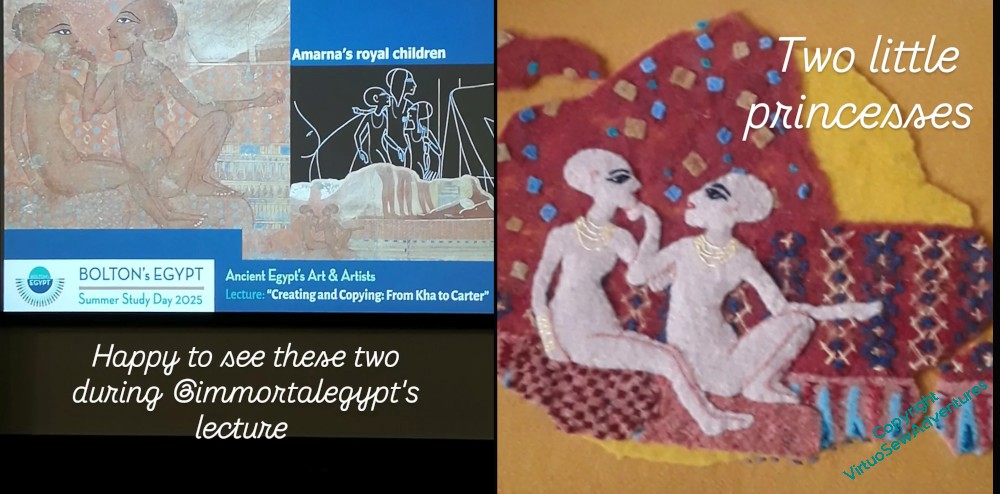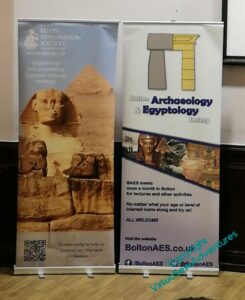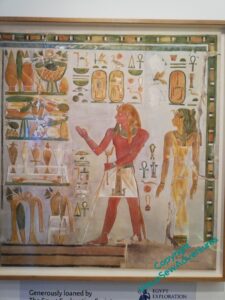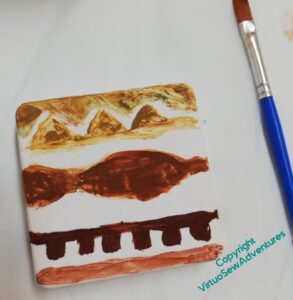Another Egyptological Outing
In the spring, I went to a Study Day in Bolton, all about Mummification, and a few weeks ago, I went to another, this one about Egyptian art, artists and art materials.
Bolton has an extensive Egyptological collection, has been associated with the Egypt Exploration Society from the beginning, and is still very much so. What’s more, the Curator, Ian Trumble, wrote the Foreword for “Dreams of Amarna”, and did some sanity checking to make sure I wouldn’t give any Egyptologists conniptions!
Part of the inspiration for the Study day was a temporary exhibition based around one of Carter’s watercolours, a record of a wall painting from Hatshepsut’s tomb, currently on loan from the EES.
We had an introduction to hieroglyphs, starting beside the painting and then touring the galleries, a handling session, and a workshop which involved some experimentation with pigments and paint. This is based on some research by Dr Stephen Buckley, who is a chemist with Egyptological leanings, and has been working on resins and oils and their usage in ancient Egypt. It’s astonishing to see how much our knowledge has exploded as it becomes more possible to analyse non-invasively.
If you look at this little tile, you can see the top two lines of pattern are pigment and water, which is what a lot of people have assumed the Egyptians used to do their paintings.
You can see that the result is blotchy, and I can tell you from experience that it was really difficult to apply: it stayed on the brush, it clumped, it refused to stay where it was put, it was just dreadful. While we were struggling, Dr Buckley made us some paint from a recipe he’s worked out from an analysis of tomb paintings.
Well now, that was altogether better. It flowed, it stayed where it was put, and it diluted into something sensible and not into something blotchy. I was delighted with it to such an extent that I said audibly “Now this is a paint I could use!” and startled a grin out of Dr Buckley!
The day started however, with a lecture from Professor Joann Fletcher, who’s known to many from her TV appearances. She is just as authoritative and enthusiastic in real life, and she took us on a whirlwind trip from the predynastic period all the way through to the recording artists, like Harold Jones or Howard Carter, who were such an important part of the team in any excavation in the early 20th century.
And look what came up to remind me of one of my favourite “Dreams of Amarna” pieces…





So what’s the magic paint ingredient? It sounds like a fascinating study day.
You must have enjoyed yourself immensely!
Oh what a delightful day out, the best kind of learning, a bit of talking, a bit of looking and a bit of practical trying things out. I love the thought of that “startled grin”.
Mary Chubb is delighting me again, about the excavations at Eshnunna (City in the Sand). I’m looking to get myself going once more on my Mesopotamian stitch explorations and thought she was the best person to help, after your book that is 🙂
What a fascinating day out! Did he give you any paint to play with?
That sounds like a fabulous day and however good the speakers, what fun to be able to do something hands on. What was the extra ingredient that made all the difference to the paint or is it a secret?!
Pigment and water, from what I have learned, would be a mess, like trying to paint with dirt from the road after a rainstorm! I’ve found it mixes well with soy milk or gum arabic… I wonder if it was some kind of tree gum/resin he used, or a “milk” of sorts. Regardless, glad he came up with something useful!